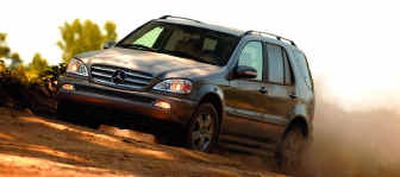Mercedes MLs reach refinement peak

In the automobile business, you throw the dice and suffer or celebrate the consequences for years.
Mercedes-Benz went down a familiar path in 1998 when it introduced its premium midsize ML320 sport-ute.
Like the cream of the existing SUV crop, which included brands like Land Rover, Toyota and Jeep, M-B bolted its plush, new rig to a truck chassis. The conventional wisdom held — and still does — that truck-based SUVs outperform car-based vehicles in off-road conditions, but that ride and handling suffer.
Mercedes bet it could master the idiosyncrasies of the truck platform and provide the kind of ride and handling its customers expected.
And they succeeded. The ML320, and the ML430 that followed, were comfortable, classy and capable. Fitted with a two-speed transfer case and other off-road essentials, the M-Class rigs would go most everywhere — including, as the ad cliché goes, to the opera.
More than 570,000 M-Class vehicles have been built at M-B’s sparkling Alabama plant.
To be sure, there were build-quality issues in the early going. Gremlins inhabited the electrical system of the first ML320 we tested; near the end of our test week, the rear passenger windows developed a mind of their own. They would descend at an apparent whim and would not be coaxed back up until the vehicle was shut down and restarted.
Just like a computer. Later iterations solved such issues.
What Mercedes couldn’t know when it introduced the ML was that the flood of competitors that would follow on the heels of its success would be car-based. And while they were not in large part as capable in off-road conditions, many buyers preferred the smoother, softer ride-quality they offer.
Nonetheless, the M-Class rigs offered cutting-edge safety innovations, outstanding creature comforts and the class and dignity befitting the M-B star.
Over the succeeding years, build-quality improved dramatically and M-B has kept its rigs current, with nearly annual upgrades to amenities and power plants. Now in their eighth year, the ML350 and ML500 have attained the peak of their refinement. With a new model due for 2006, these vehicles represent the highest expression of decisions made by M-B brass a decade ago.
We recently tested a 2005 ML500, powered by a 288-horsepower, 5-liter V-8 and outfitted with a new Special Edition options package; it reminded us why we had liked its original progenitor, despite its wayward windows.
There is nothing insubstantial about the ML500. The doors close with a solid, satisfying “thunk!,” assuring one on some primal level that all is well. The interior is attractive and decidedly upscale without going overboard. Over the years, M-B has focused a fair amount of time and energy on this interior, enhancing the quality of the materials and the feel of the switchgear.
With its gathered leather and polished wood trim, it’s one of the most pleasing cabins in the class. Some might find the interior a bit dark-toned for their tastes, but I like its somber stylishness.
The seats are hard to beat, too. They’re large and supportive, though not so firm to raise a complaint from the soft-on-my-tush crowd.
Likewise, the exterior has, to my eye, held up well over the years. The M-Class manages to combine sturdy, upright lines with a sloping hood and vaguely wedge-shaped profile to look both studly and graceful in a single stroke.
The $1,300 Special Edition package adds a power dome to the hood, new 17-inch, five-spoke wheels and body-colored running boards, all of which dress up the M-Class nicely.
It also adds sport seats, with memory; rain-sensing wipers; power folding exterior mirrors; a silver-painted star; and special badging inside and out — a package M-B values at $3,100 if all items were bought separately.
Built on a fully boxed steel frame, the M-Class rigs incorporate a reinforced body cage with front and rear crumple zones.
Other standard safety gear includes a full complement of airbags, including curtain-style bags front and rear; three-point seat belts at all positions; four-channel antilock brakes with brake assist; and electronic stability control.
It all adds up to a 4,800-pound rig that feels as solid as it looks. A steering system that feels like real steering and not like over-boosted mush contributes to the sensation. Likewise, the brakes in our tester were firm and linear.
The 5-liter eight makes 288 horsepower, every bit of which seems to get to the ground. The Benz leaps off the line and accelerates neatly through the five-speed automatic transmission, with a 0-60 time of 7.4 seconds. M-B trannies tend to be tweaked to provide ultra-smooth shifts, often at the expense of quickness, but the ML’s box strikes a nice compromise.
Largely because of its truck origins, the M-Class handles less crisply at speed than most of its car-based brethren. It’s not a hog, but neither is it a vehicle that invites tossing in the twisties.
Its aging chassis betrays it in another way, too, especially on rough and uneven surfaces, where the structure exhibits more flex than would a unibody setup.
The ML vehicles have held up well for the duration of their eight-year run, although in some respects they omit amenities considered de rigueur in the class, including steering-wheel-mounted audio controls, adjustable lumbar support, rear DVD entertainment system and satellite radio.
I expect we’ll see all that and more in next year’s model.
Mercedes-Benz owners and wannabes — you know who you are — won’t find much to fuss about in this generation of MLs. Where the rubber meets the road in terms of build-quality, overall comfort, utility and ride characteristics, the ML320 and ML500 have held their own through the years.